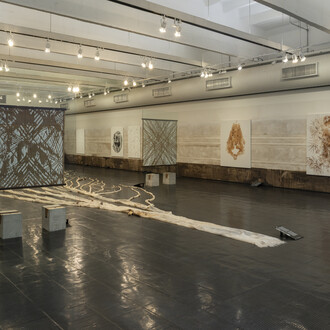Galeria Leme is pleased to present Widows, orphans and strangers, a solo exhibition by British artist Henry Krokatsis, on view from May 17 to June 14, 2025.
Featuring 11 works by the artist, the exhibition marks his return to Brazil after twelve years.
In Widows, Orphans & Strangers, Krokatsis actively brings the margins into focus. The show’s title alludes to those often relegated to the periphery of society, whilst also carrying a lateral meaning: in typesetting, a line or words separated from the main body of text are referred to as ‘widows’ and ‘orphans’.
Krokatsis’ work invites a reconsideration of materials that are themselves castoffs. Working mostly with salvaged mirrors—typically sourced from junk shops and car boot fairs—the artist seeks to reinterpret, reposition, and revalue objects that have metaphorically “lost their shine”.
Krokatsis is fascinated by the parallels between the history of the modern world and that of the mirror, particularly in cycles of material obsolescence and devaluation. Mirror-making was once a mystical craft, deeply connected to science, astronomy and the esoteric, however, during the twentieth century, skilled mirror-making techniques were rapidly supplanted by cheap, mass-produced alternatives. The widespread introduction of mirrors into British households in the latter half of the last century made banal what had become a signifier of wealth and luxury, a status symbol becoming a commonplace surface—one that tarnished easily and often ending up discarded. By incorporating these objects into his artworks, the artist extends their life cycle and reassigns their value. These often-imperfect mirrors are treated like elements of a painting as the artist cuts and reshapes them into new visual realities.
In these works, the reverse of the mirror is revealed and engaged as a significant compositional element. Mirrors are produced by sealing a silver layer behind a sheet of glass to create the reflective surface. Their backs are then sealed with various materials to protect against corrosion, exposing a surprising spectrum of colours – ranging from cadmium orange, copper browns and reds, to aluminum blues. By activating the “useless” side of the discarded object, Krokatsis draws out a rich additional narrative embedded in the cultural and religious traditions that turn or cover mirrors during mourning to mark a period of spiritual contemplation.
Ultimately, Henry Krokatsis is inviting the viewer to look again, to reassess the value in what we take for granted or have discarded. By using mirrors to propose this reflection he directs our attention to the nuance and meaning in what often lies at the margins of everyday life.













